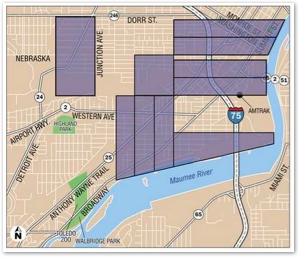
Originally published in The Blade on Friday, November 21, 2008
BY RYAN E. SMITH
BLADE STAFF WRITER
History is full of what-if moments.
What if D-Day had failed? What if 9/11 had been prevented? What if Tom Cruise had never jumped on Oprah's couch?
For Toledoans, especially on the eve of the Ohio State-Michigan football game, there is an even bigger question: What if the University of Michigan had been located here?
It could have happened.
The proof is in plain sight, written on a freestanding plaque along Huron Street in downtown Toledo, between Washington and Lafayette streets near Grumpy's restaurant. It reads, in part:
"One of Toledo's oldest neighborhoods and originally in Michigan, Huron St. Village was considered as the site of the University of Michigan. After the outcome of the Michigan-Toledo War of 1835 the area was permanently established in Ohio and averted the proposed location of the University from here."
My eyes practically popped out of my head when I read that, but it's all true.
Here's what happened. Back in the early 1800s when Michigan was still a territory, the precise border with Ohio remained murky. By some maps, the region that would become Toledo was considered part of Michigan.
After Native Americans relinquished their claims to land in this area, a portion of it went to support higher education in Michigan in compliance with the Northwest Ordinance of 1787. The land selected ended up being about 1,000 acres of prime waterfront property in and to the south of what is now downtown Toledo, according to Andrew Ten Brook in his 1875 book American State Universities: Their Origins and Progress.
Which means that instead of watching ball games at Fifth Third Field, we could have had Michigan Stadium. We could have had Michael Phelps training here. Who knows, maybe we'd even have a Trader Joe's.
But you know how this story ends, and that has Buckeye fans breathing a sigh of relief. Any chance the Glass City had of becoming ground zero for Wolverine Nation ended with the so-called Toledo War.
Ohio claimed the town as its own. So did Michigan. Militias were called out and everyone got a little testy. In the end, the federal government sided with the Buckeye State and Michigan got the Upper Peninsula and statehood as a consolation prize in 1837.
It was around this time that the University of Michigan started selling its land in Toledo - for peanuts. Ten Brook laments, "The Toledo lands, which might have brought the university some millions altogether, brought about $17,000."
The biggest winner in all of this may have been Ann Arbor, which became home to the university in 1837 after it offered 40 acres of free land. If Toledo had remained part of the state, it's easy to imagine how tempting a site it would have been for a school that already owned so much property there.
"It would have made one beautiful campus," said Glenn Fitkin, Jr., a local history buff from Ottawa Hills who wrote a paper at the Toledo-Lucas County Public Library on the university's connection to Toledo. "They might have been better off than the Ann Arbor campus."
But would we?
It's easy to dream about what such a parallel world would mean to today's Toledoans. Picture the city with a stately riverfront campus filling a large stretch between downtown and the Toledo Zoo. Think of all the culinary and cultural offerings that would sprout up around it. Consider the national spotlight it would bring to this community, even when it's not time to elect a president or play football.
It sounds breathtaking. And yet, despite all this, I find myself smiling that history worked out the way it did. Maybe it has to do with concerns about changing Toledo's personality or how a blue-collar town would mix with the University of Michigan's ivory towers.
Or maybe it has something to do with something else - like the scarlet and gray T-shirt I'll be wearing tomorrow.
RANDOM SAMPLES




This is the land owned by the University of Michigan in Toledo over the years. Not all of it was possessed at the same time. (BLADE GRAPHIC)